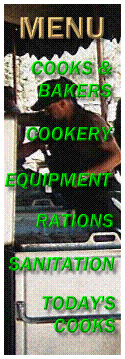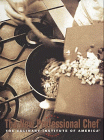
David Castle's Army Kitchen Truck
Food Preparation and Serving
Excerpted from the 1967 edition of Army Mess Operations (TM 10-405)
[Food preparation and cooking] [Serving]
Feeding troops in combat has always been tough. Since commanders recognize that good morale comes with serving hot chow to troops in the combat zone, aggressive commanders instructed their cooks to bring one or two hot meals forward each day, often under the cover of darkness. These commanders knew what happened to morale when their troops subsisted on C-rations for weeks on end.
Lt. Col. Coy W. Baldwin wrote in the May-June 1953 of the Quartermaster Review: "Still more surprising is that old campaigners learn to realize the truth of a saying that has become axiomatic in Korea -- 'the farther forward, the better the food.'" By the time Korea and Vietnam rolled around, the Army and the Marines had perfected the art of feeding hot meals to combat troops.
Although it is desirable for mess personnel to prepare the supper meal in the rear area, it will sometimes be necessary for them to prepare this meal, at least in part, while the kitchen truck is en route to the combat area. Careful plans must be made for such an emergency. Plans should take into consideration:
-
Distance to be traveled
-
Condition of the roads to be used
-
Type of food to be used
-
Cooking methods contemplated
-
Amount of time available after the truck has reached its destination
The mess steward must train mess personnel to prepare and cook food in a moving truck. He must stress safety measures. Cooking may be done by almost any method except deep-fat frying. Food should never be deep-fat fried while the truck is moving because sudden stops or jerky movements of the truck may cause hot grease to splash on personnel and cause serious injury. Truck vibration prevents the preparation of cakes and yeast-leavened doughs, but pies and biscuits may be baked en route.
When food is served from the kitchen truck, procedures used in the garrison mess should be followed as closely as possible. Emphasis should be placed on portion control because the supply of food in the kitchen truck is limited to the actual needs of the troops to be fed. The serving line cannot be backed up with leftovers, as is the case in the garrison mess.
The use of the staggered serving line is recommended for two reasons:
-
It speeds up serving because two lines can be served at the same time
-
It spreads out the troops, thereby reducing the number of casualties should the enemy attack while serving is in progress
However, if the weather is inclement and if the danger from enemy fire is not imminent, the serving line may be set up under the extended tent fly and the food served from the collapsible serving table.
David Castle's Restored Army Kitchen Truck
Bibliography
Dept. of the Army. Army Mess Operations. TM 10-405. Washington: GPO, August 23, 1967. 150pp. This information is taken from pages 59-60.
May 2000
| Bulletin Board | Keyword Search |
| Bookstore | Links |
| About Us | Recent Additions |

